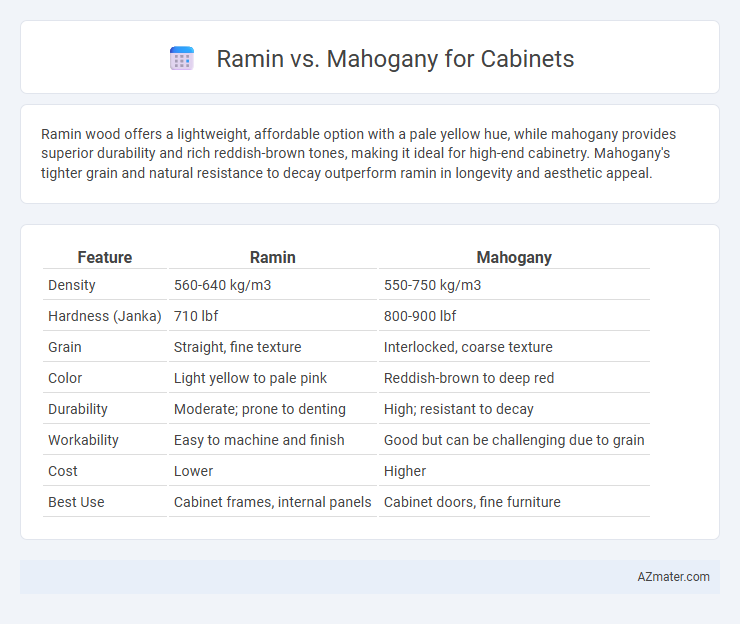Ramin wood offers a lightweight, affordable option with a pale yellow hue, while mahogany provides superior durability and rich reddish-brown tones, making it ideal for high-end cabinetry. Mahogany's tighter grain and natural resistance to decay outperform ramin in longevity and aesthetic appeal.
Table of Comparison
| Feature | Ramin | Mahogany |
|---|---|---|
| Density | 560-640 kg/m3 | 550-750 kg/m3 |
| Hardness (Janka) | 710 lbf | 800-900 lbf |
| Grain | Straight, fine texture | Interlocked, coarse texture |
| Color | Light yellow to pale pink | Reddish-brown to deep red |
| Durability | Moderate; prone to denting | High; resistant to decay |
| Workability | Easy to machine and finish | Good but can be challenging due to grain |
| Cost | Lower | Higher |
| Best Use | Cabinet frames, internal panels | Cabinet doors, fine furniture |
Introduction: Ramin vs Mahogany Cabinets
Ramin and Mahogany are two popular wood choices for cabinets, each offering unique characteristics in grain, color, and durability. Ramin wood is known for its light, creamy yellow tone with fine, uniform texture, making it ideal for sleek, modern cabinets. Mahogany, prized for its rich reddish-brown color and exceptional strength, provides a classic, elegant appearance that enhances the value and longevity of cabinetry.
Wood Origins and Botanical Overview
Ramin wood originates from the Shorea genus predominantly found in Southeast Asia, especially Malaysia and Indonesia, known for its fine grain and light color. Mahogany, primarily sourced from the Swietenia genus native to Central and South America, is valued for its rich reddish-brown hue and durability. Both woods offer distinct botanical characteristics that influence their texture, density, and suitability for cabinetry, with ramin providing a straighter grain and mahogany exhibiting a more complex pattern.
Appearance and Color Differences
Ramin wood features a pale, creamy yellow color with a smooth, even grain, providing a light and consistent appearance ideal for bright, modern cabinetry. Mahogany exhibits a rich, deep reddish-brown hue with pronounced grain patterns, creating a luxurious and classic look often favored for traditional or upscale cabinets. The contrast between Ramin's subtle, uniform tones and Mahogany's vibrant, textured finish significantly influences choice based on desired aesthetics and interior design style.
Grain Patterns and Texture
Ramin wood features a fine, consistent grain pattern with a smooth texture that enhances cabinet surfaces with a subtle, natural appearance, making it ideal for clean, minimalist designs. Mahogany, known for its pronounced, interlocking grain and rich, reddish-brown hues, offers a luxurious texture and striking grain variation that adds warmth and character to cabinetry. Both woods provide durability, but the choice between the delicate grain of Ramin and the bold texture of Mahogany depends on the desired aesthetic impact of the cabinets.
Durability and Hardness Comparison
Ramin wood, sourced from Southeast Asia, exhibits a moderate Janka hardness rating of approximately 830 lbf, offering decent durability for cabinet construction. In contrast, Mahogany, with its higher Janka hardness ranging between 800 to 900 lbf depending on the species, tends to provide superior hardness and resistance to denting and wear. While both woods present good durability, Mahogany generally delivers enhanced strength and longevity for cabinet applications, making it preferable in high-traffic or heavy-use environments.
Workability for Cabinet Making
Ramin wood offers excellent workability for cabinet making due to its smooth texture, uniform grain, and ease of machining, making it ideal for detailed carvings and intricate joinery. In contrast, mahogany provides superior durability and a rich finish but may require more effort in sanding and shaping because of its denser fibers. Both woods support strong adhesive bonding and finishing, but Ramin's lighter weight often results in faster processing and reduced tool wear.
Environmental Impact and Sustainability
Ramin wood, sourced primarily from Southeast Asia, faces significant environmental concerns due to overharvesting and habitat depletion, impacting sustainability efforts negatively. Mahogany, especially when certified by FSC (Forest Stewardship Council), offers a more sustainable alternative as responsible logging practices and plantation growth help preserve biodiversity and reduce deforestation. Choosing FSC-certified mahogany supports sustainable forestry and promotes reduced carbon footprints compared to ramin's current ecological challenges.
Cost and Market Availability
Ramin wood is generally more affordable than mahogany, making it a popular choice for budget-conscious cabinet projects. While mahogany offers superior durability and a rich, deep color, its higher cost is driven by limited market availability and increased demand in premium cabinetry. Ramin's widespread availability in Southeast Asia contributes to its lower price and accessibility in the woodworking market.
Ideal Applications in Cabinetry
Ramin wood, known for its lightweight and smooth grain, is ideal for intricate cabinet components like drawer fronts and interior panels that require detailed machining. Mahogany, prized for its durability and rich reddish-brown color, excels in high-end cabinetry where a luxurious appearance and long-lasting structural integrity are essential. Both woods offer excellent workability, but Ramin suits budget-friendly, decorative interiors while Mahogany is favored for premium, visible cabinet exteriors.
Choosing the Best Wood for Your Cabinets
Ramin wood offers a lightweight, smooth texture ideal for intricate cabinet details, while mahogany provides superior durability and rich, deep reddish-brown tones that enhance cabinet aesthetics. Mahogany's natural resistance to moisture and insects makes it a long-lasting choice for both kitchen and bathroom cabinets, whereas ramin is more budget-friendly and easier to work with for custom cabinetry. Selecting the best wood depends on balancing durability needs, budget constraints, and the desired finish for your cabinets.

Infographic: Ramin vs Mahogany for Cabinet
 azmater.com
azmater.com